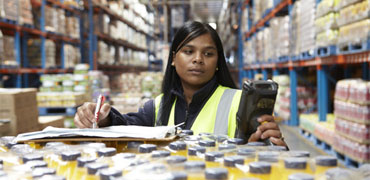The consumer goods landscape is undergoing some massive changes.
Companies are facing a complex mix of pandemic supply chain disruptions, new trends, and economic and environmental challenges.
But what stands out from all of this is that consumers are becoming more demanding. At the beginning of the pandemic, bulk buying surged by 20%1 and, with the rise in online ordering, many now expect same-day delivery.
For manufacturers, this means increased pressure to drive down production time and to speed up fulfilment. Many companies are turning to new technologies such as the internet of things to help, using it to connect operational technology to the cloud to give a data-driven view of where improvements can be made. 88% of companies say they are now capturing data in this way, but only 18% feel this information is properly connected to systems that can translate information into decisions which increase efficiency2.
Consumer goods companies need to do more and reach further if they’re to stay competitive – so where do they start?
It’s the perfect time to reinvent
It’s clear that traditional infrastructure isn’t going to be enough to keep companies relevant and competitive in this changing landscape. They’ll need to make more of their factory compatible with IoT technology if they’re going to see greater benefits. We know that a third of organisations have already made a third of their factories smart3, but to thrive in today’s environment means fully revising their ageing infrastructure.
A completely smart factory will connect every level of your operation, merging IT and OT together to give you better insights to your factory operations. You’ll be able to make real time decisions which will improve output, downtime and profitability. By building a solid foundation for digital transformation you’ll also open up opportunities to improve further efficiencies and increase your bottom line.
Moving to a smart factory involves three steps:
1. Start with a secure, robust connection
In the factory of the future, connectivity brings everything together, so you need the best possible underlying network to support your operation. It can help to see connectivity and productivity as the same thing. If a connection is broken or security is breached, it means service disruption, costly downtime, and lower productivity. Consider upgrading your connection for greater coverage, enhanced security, and to support new technologies like SD-WAN which can prioritise network traffic for production.
2. Integrate 5G
5G will profoundly change the way factories are connected with its scalability, reliability and far lower latency than traditional wi-fi that enables real-time communications across millions of sensors, devices and systems. Integrating 5G is not only a catalyst for transformation, it’s the gateway to the next generation of operations, opening up exciting possibilities for your manufacturing, including intelligent automation like AI, advanced robots, and digital twins.
3. Fully automate your factory floor
Imagine a future where factories no longer keep the lights on, because humans rarely set foot inside. All day long, the machines generate a constant flow of data that they use to autonomously respond to fluctuating demands in real time. For some manufacturers, this is already a reality, bringing a more efficient use of materials, higher quality products, shorter hours for staff and improved safety, for starters. The smart factory’s ability to take on manual tasks and basic cognitive skills, frees up your workforce to focus on their creativity, analytical skills and technical knowledge in other areas. And once you have a secure, scalable network and 5G you’re ready to explore the possibilities of other smart solutions like robotics, computer vision and AI across the entire factory.
A connected factory is only the beginning
Once you’ve reached this stage, your operation is ready to make the most of digital technologies to improve efficiency and maintain a competitive edge. Over the next few weeks, we’ll be exploring the following possibilities in our new series of blog posts for consumer goods companies:
1. Transparent supply chain
Building a resilient supply chain that can adapt to unplanned changes or disruptions takes total synchronisation. This gives you the capacity to monitor your entire production line from your warehouse logistics to your inventory. Tracking assets, tools and people connects the entire process for a more complete, data-driven view. The added visibility can support smart business decisions that address inefficiencies, accelerate fulfilment and exceed customer demands.
2. Intelligent manufacturing
The smart manufacturing solutions of Industry 4.0 address manufacturers’ concerns around security, sustainability and safety. Choose cybersecurity measures tailored to Industry 4.0 to protect your industrial operations from intrusion. Implement predictive and preventative maintenance systems to improve factory safety and reduce downtime. And use connected devices to generate real-time analytics and actionable insights, so you can operate more sustainably by reducing energy and resource consumption.
3. Empowered smart workforces
Your operations can only evolve as fast as the people who run them. Connected factories require a new way of working and a rethink of how you use your workforce, empowering them with new skills and the potential to collaborate across your entire chain. Encouraging your employees to fully embrace these changes will drive your transformation and increase operational agility.
4. Exploring new channels to market
Consumer goods companies need to reinvent their digital markets to keep up with a rapidly evolving relationship between brands and consumers. If you can’t find innovative ways to stay relevant and build connections with your customers, all the hard work revolutionising production will be wasted.
Start your transformation journey
We have a range of secure connectivity solutions that can help you to build your connected factory, including SD-WAN, 5G and cloud capability to reinforce your networks. Plus, we work with a range of partners who can help you adopt intelligent automation technology inside your operation.
Watch out for our insights on how to get the most from your connected factory, in our new blog post series. If you’d like to know more visit Digital Consumer Goods.
1The Grocer, ‘What’s happening to grocery shopping habits as lockdown eases?’, 2020
2Zebra, ‘Building a Smarter, More Connected Plant Floor with IoT’, 2020
3Capgemini, ‘Industry 4.0: Discovering the power of smart factories’, 2019

